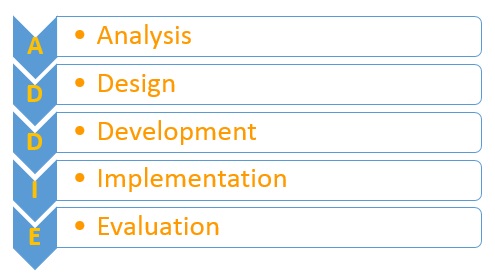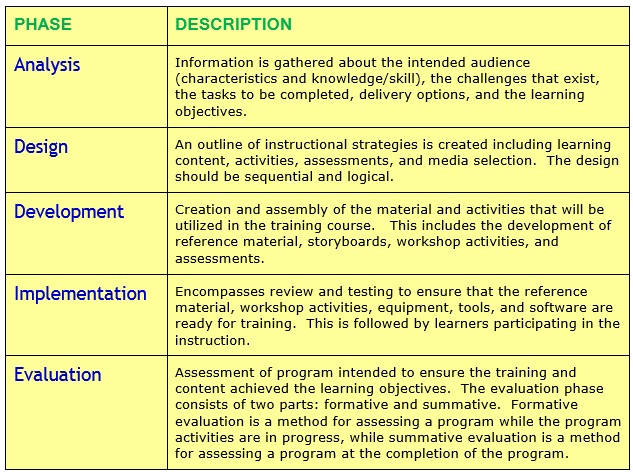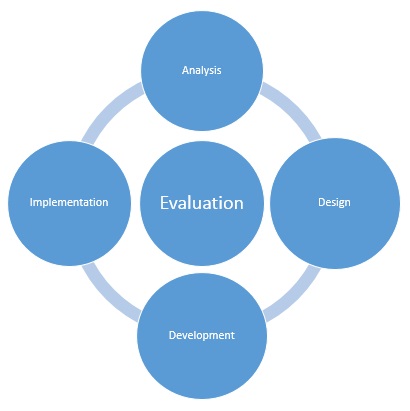The ADDIE Model is an approach used by instructional designers to design courses and create instructional materials. It is considered the most common model used for creating instructional materials. ADDIE is an acronym for Analysis, Design, Development, Implementation, and Evaluation.
The ADDIE Model
The ADDIE model is a flexible guidelinefor building an effective training course. It is basically a strategic plan for course design and development. The ADDIE process is a cycle, in which each step has an outcome that feeds into the subsequent step. Also, the model is flexible enough to allow each step to be revisited, reviewed, and refined if necessary.
The first step in the ADDIE model is analysis. In the analysis phase, information is gather about the intended audience, the challenges, the tasks to be completed, delivery options, and the learning objectives. The second phase is design. This is where an outline of instructional strategies is created and learning activities and assessment are determined. The design should have a logical and orderly sequence for attaining the learning objectives. The design stage is followed by the development phase where the learning content, learning activities, and learning assessments are developed. After the material is develop, the implementation phase begins. This phase includes testing the any equipment, software applications, and/or websites to ensure it is assessable and functional for the participants. This stage also includes learners participating in the instruction.
The final stage of the ADDIE Model is the Evaluation. This phase consists of two parts: formative and summative. Formative evaluation is a measurement of learning outcomes during the instruction process, while summative evaluation is measurement of learning outcomes after instruction. Summative evaluation is the final stage. The ADDIE model allows the designer to assess the course or program elements and revise them as necessary.
ADDIE Model
Analysis
In the Analysis phase, information is gathered about the intended audience, the challenges or problems that may exist, the tasks to be completed, delivery options, and the learning objectives. This phase helps determine the basis for all future decisions. A proper analysis helps identify potential problems, limitations, opportunities, or other important points that will be useful in the design and development process.
Questions addressed during the analysis phase include:
- Who is the intended audience?
- What are the characteristics of the intended audience?
- What is the knowledge or skill level of the intended audience?
- What is the intended new behavioral or performance outcome?
- What are the learning objectives?
- What types of learning constraints exist?
- What are the time restraints?
- What are the delivery options?
Design
In the design phase, information obtained from the analysis phase is used in conjunction with learning theories and principles of learning. The design stage determines the strategies used create the program.
The design phase begins with establishing the learning objectives. Then tasks are identified and broken down to be manageable segments. The entire course design should be systematic and logical with each segment linked to and building on the previous. After the tasks are segmented, strategies regarding the delivery method, content material, technology, and the tools to be used are addressed. After which, exercises or activities are designed for the participants in order for them to practice the new knowledge or learned skills. The final step in the design phase is to determine the kind of assessment that is required to verify the learning objectives are met.
Strategies addressed during the design phase include:
- delivery method
- content material
- tools and technology used
- instructional activities
- activities to gauge participant’s performance
- assessment instruments
Development
The development phase involves the creation of the material and activities that will be utilized in the training course. In this stage, the strategies selected in the design phase are developed and assembled. That includes development of storyboards, workshop activities, reference material, as well as integration of any technologies such as videos and simulations. Usually in this phase, material is first drafted then it is reviewed and revised according to any feedback given until the final product is complete and ready for implementation.
Implementation
After the content is developed, it is then implemented. This phase begins by ensuring that the reference material, workshop activities, equipment, tools, and software are ready for training. This would include testing the any equipment, software applications, and/or websites to ensure it is assessable and functional for the participants. This stage may also include participant preparation. Participant preparation may include activities prior to the actual training course including introduction to new software, initial skill assessment, or registration. However, the focus of the implementation phase is the actual involvement of the participants in the training course.
Evaluation
The final phase of the ADDIE Model is the evaluation phase. This phase is intended to ensure the training and content achieved the learning objectives. It provides information used to modify and enhance the course for future participants.
The evaluation phase consists of two parts: formative and summative
Formative evaluation is a method for assessing a program while the program is being formed or in progress. Formative evaluation help monitor how well and if the learning objectives are being met.
The main goal of formative assessment is to monitor learning to provide ongoing feedback that can be used by instructors and designers to improve the program. It helps to guide instruction and provide valuable information for the instructor and for the learner. It can help recognize where people are struggling and make adjustments during the class.
Summative evaluation is a method for assessing a program at the summation or end of the program activities. Summative evaluation consists of tests, surveys, interviews, observations, and other assessments taken at the end of the training.
Unlike formative evaluation, which is done as the session is being implemented or created, summative evaluation is done after implementation of a course.
Summative assessments are valuable because they let us know whether the learners have successfully learned what we intended them to learn. Unfortunately, because they are done at the end of instruction, summative assessments are limited in that they provide little to assist the instructor during the course. However, information from summative assessments can be used to guide efforts and activities in subsequent courses.
Additional Links
Gagnes Nine Events Instruction
Kirkpatricks Four Levels of Evaluation




